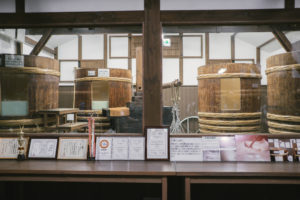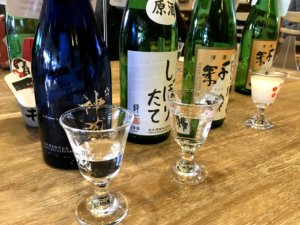What are “Kimoto” and “Yamahai” on sake labels?
When you walk into a sake shop and choose a sake, the first thing you will probably see is the label. On the label, there is a variety of information that will help you imagine the characteristics of the sake.
Have you ever found the words “Kimoto” or “Yamahai” on a sake label?
So what are these “Kimoto” and “Yamahai”?
Shubo, Yeast Starter – The foundation of sake
Shubo (Yeast Starter) is one of the most important steps in sake brewing. The sake mother is the foundation for making sake, and its purpose is to cultivate a large amount of yeast to produce alcohol.
Yeast is extremely delicate, and will quickly die if microorganisms or germs get into it. While yeast is susceptible to microbes and bacteria, it is also resistant to acidity.
The key to making Shubo is how to maintain acidity, and lactic acid is used for this purpose.
There are two types of Shubo, the fast brewing type and the traditional sake brewing type. The type of Shubo depends on how this lactic acid is obtained.
- Quick brewing type Shubo is a type of Shubo to which artificially created lactic acid is added to maintain acidity.
- Kimoto shubo is made by incorporating natural lactic acid bacteria that live in the brewery.
Differences between “kimoto” and “Yamahai” brewing methods
The first two types of sake, kimoto and Yamahai, are made using the kimoto type Shubo.
Kimoto Type Shubo
Since natural lactic acid bacteria are used, it takes longer than the fast brewing method. It also requires frequent monitoring to prevent bacteria from entering the environment before the lactic acid has fully formed.
In order to make this kimotokei Shubo, we first generate the natural lactic acid bacteria that are dormant in the brewery and brewing tools. Once the lactobacilli are sufficiently produced and the number of microorganisms and germs has been reduced, yeast is added.
Yeast is resistant to acidity and will increase to feed on the sugars contained in the rice. Alcohol is produced when the yeast consumes the sugar, and as the alcohol concentration increases, the alcohol kills the lactic acid bacteria. As a result, the lactic acid bacteria are killed by the alcohol.
There is a traditional process called “yamaoroshi” that is used to produce lactic acid bacteria in the production of kimoto shubo.
This is the process of putting steamed rice, koji, and brewing water into a vat and mixing them while grinding them every few hours.
In the cold winter months, two people work day and night to mix the ingredients in one vat.
Kimoto requires this “yamaoroshi” process. On the other hand, Yamahai does not have this process. Both “kimoto” and “yamahai” have the same foundation, the shubo-yeast starter, so they are like brothers.
The Difference in Taste Between “Kimoto” and “Yamahai” / Recommended Food Pairings
So, what kind of flavor and taste does sake made with kimoto have?
The strong yeast in kimoto sake eliminates more of the sources of miscellaneous flavors.
As a result, it has a crisp, clean and clean flavor, and a powerful taste with a rich aroma and full body.
In addition, since natural lactic acid is used, you can feel the natural sourness.
It goes well with dishes that use cream cheese, butter, and miso, such as bagna cauda and mackerel cooked in miso.
Yamahai-brewed also has the same tendency as it is brewed with the same kimoto type Shubo.
However, Yamahai-brewed sake is more mellow in flavor than kimoto-brewed sake.
Yamahai-brewed sake contains more amino acids than kimoto-brewed sake, so rather than enjoying the aroma, you can enjoy a fuller, richer flavor.
Yamahai-brewed sake has a more robust flavor, so it goes well with dishes that have a strong flavor, such as yakitori (grilled chicken) and pork kakuni (stewed pork).
You can also enjoy it with cheese and creamy dishes such as rich cheese fondue because it also has a delicious flavor.
Recommed Yamahai-brewed Sake

Tamanohikari “Classic”
- Kyoto Prefecture
- True sake lovers will be satisfied with a glass of yamahai sake. Tamanohikari Brewing Company spends extra time and care during the brewing process, but the result is well worth the wait. This junmai ginjo boldly mixes acidity and sweetness into a unique flavor. Open up to a new sake experience and add this one to your collection.
Recommended Kimoto-brewed sake (List)
Let’s have a sake experience!
On the labels of sake, there are hints here and there about what kind of taste and flavor the sake has.
Once you get the hang of it, it’s not difficult to choose the sake you want.
With Kyoto Insider Sake Experience’s brewery tours, you can get closer to the secrets of Fushimi Kyoto and its sake brewing history, whilst enjoying learning about and tasting all the different sake varieties that can be found here.






When visiting Kyoto, you can’t miss a sake tour of Fushimi – so why not join us on a hunt for the area’s best sake, and best combination with food pairing session and find your favourite along the way?
Have a nice sake life 🙂

Name: Kotaro
Qualifications: Sommelier of sake
About me:
Founder of Kyoto Insider Sake Experience.
I got a hangover from the first sake I ever drank, which led to a long period where I didn’t drink sake at all. After returning from Australia, I gained some knowledge about sake and discovered its deliciousness and the joy of choosing different types. I’m passionate about sharing this experience with people all around the world.








